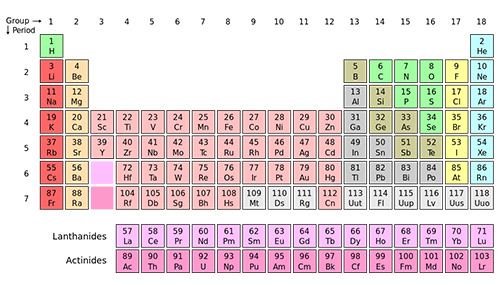The Magic of Batteries
Today, the magic of batteries. The University of Houston's College of Engineering presents this series about the machines that make our civilization run, and the people whose ingenuity created them.
A "Magic Show" is about to begin... Instead of a deck of cards, we're playing with a deck of elements, the periodic table. We choose one item from the left side and one from the right. We bring them together until they touch... They react... gently or in some cases, violently. One assumes the role of electron giver; one becomes the electron receiver. Their byproduct grows in between... That was our "preshow".
Now, we choose a metal element from the middle right and another from the middle left-- like nickel and cadmium or copper and zinc. This time, we don't let them touch. We separate them with a special material that allows the ions to pass but not the electrons. On the outside, we connect the wires to our elements and let the electrons flow through... Our two elements react, but this time, controlled by us. We have redirected the path of electrons to our advantage. We connect a small light bulb to the wires... A-N-D it lights up... YES, we've made a battery.
![A Lemon Battery: A copper coin and a zinc coated nail are inserted into a lemon. The copper and zinc act as the electrodes and the lemon behaves as an electrolyte. [Courtesy of Reed Newell and Haleh Ardebili at University of Houston]](/sites/engines/files/images/page/2893-lemon_battery.jpg)
A Lemon Battery: A copper coin and a zinc coated nail are inserted into a lemon. The copper and zinc act as the electrodes and the lemon behaves as an electrolyte. [Courtesy of Reed Newell and Haleh Ardebili at University of Houston]
Benjamin Franklin first coined the term "battery". He was actually referring to an array of charged glass plates. In 1786 Luigi Galvani placed a dead frog between two dissimilar metals and it twitched. He was very close to discovering the battery phenomenon. In few years later, Alessandro Volta made a battery by piling up layers of silver, paper soaked in salt, and zinc.
![Cross-section of a copper/zinc cell with a sulfuric acid electrolyte. [Wiki]](/sites/engines/files/images/page/2893-cross_section.jpg)
Cross-section of a copper/zinc cell with a sulfuric acid electrolyte. [Wiki]
The existence of batteries may actually date back 2200 years... A clay jar turned up in an ancient tomb near the city of Baghdad. An iron rod protruded from the center, surrounded by a tube made of copper sheet. It appears to have been an ancient battery, probably used for electroplating...
Nowadays, batteries are abundant in number, shapes and types. Some are primary batteries meaning that we cannot charge them... some are secondary or rechargeable batteries. When we push the button on our TV remote control or cell phone, we're collecting the redirected electrons from the batteries. The ions move inside the battery from one active material to another. We call these two materials, "the electrodes" and what's between them, "the electrolyte" and "separator". We try to use the best materials for electrodes and electrolytes and the most creative designs and structures to make these electrochemical interactions last for a long time.
I'm Haleh Ardebili at the University of Houston, where we're interested in the way inventive minds work.
(Theme music)
Notes and references:
The periodic table and copper/zinc cell images are courtesy of Wikipedia. The lemon battery image is courtesy of Reed Newell and Haleh Ardebili at the University of Houston.
This episode first aired on July 10, 2013.
